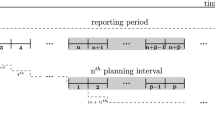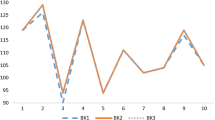Abstract
The guaranteed service model (GSM) computes optimal order-points in multi-echelon inventory control under the assumptions that delivery times can be guaranteed and the demand is bounded. Our new stochastic guaranteed service model (SGSM) with Recourse covers also scenarios that violate these assumptions. Simulation experiments on real-world data of a large German car manufacturer show that policies based on the SGSM dominate GSM-policies.

Similar content being viewed by others
Notes
In fact, service level requirements can be prescribed also in the SGSM by using the original GSM demand constraints for the nodes for which this is desired, see Sect. 2.
In practice, before implementing a safety-stock computation based on the SGSM, it seems advisable to test an increasing number of scenarios (generated and reduced) until simulation results do not significantly change anymore or until the computation times become prohibitive. We know of no method that would allow an a-priori estimation of the number of scenarios necessary for an SGSM instance to guarantee a prescribed optimality gap compared to the SGSM instance with the underlying (non-finite) distributions.
References
Birge JR, Louveaux F (1997) Introduction to stochastic programming. Springer, New York
Clark A, Scarf H (1960) Optimal policies for a multi-echelon inventory problem. Manag Sci 6:475–490
Diaz A, Fu MC (2005) Multi-echelon models for repairable items: a review. Document in decision, operations & information technologies research works. University of Maryland. http://hdl.handle.net/1903/2300
Doǧru M, de Kok A, van Houtum G (2005) Optimal control of one-warehouse multi-retailer systems with discrete demand. Working paper
Graves S, Willems S (2000) Optimizing strategic safety stock placement in supply chains. Manuf Serv Oper Manag 2(1):68–83
Heitsch H (2007) Stabilität und Approximation stochastischer Optimierungsprobleme. PhD dissertation, Humbold-Universität zu Berlin
Heitsch H, Römisch W (2003) Scenario reduction algorithms in stochastic programming. Comput Optim Appl 24:187–206
Henrion R, Küchler C, Römisch W (2008) Discrepancy distances and scenario reduction in two-stage stochastic mixed-integer programming. J Ind Manag Optim 4(2):363–384
Inderfurth K (1991) Safety stock optimization in multi-stage inventory systems. Int J Prod Econ 24(1–2):103–113 (1991). doi:10.1016/0925-5273(91)90157-O. http://www.sciencedirect.com/science/article/pii/092552739190157O
Inderfurth K (1994) Safety stocks in multistage divergent inventory systems: a survey. Int J Prod Econ 35:321–329
Schade K (2008) Lagerhaltungsstrategie für mehrstufige Lagerhaltung in der Automobilindustrie. Master’s thesis, Universität Bayreuth
Magnanti T, Shen ZJ, Shu J, Simchi-Levi D, Teo CP (2006) Inventory placement in acyclic supply chain networks. Oper Res Lett 34:228–238
Minner S (1997) Dynamic programming algorithms for multi-stage safety stock optimization. OR Spectrum 19:261–271. doi:10.1007/BF01539783
Rambau J, Schade K (2010) The stochastic guaranteed service model with recourse for multi-echelon warehouse management. In: Proceedings of the international symposium on combinatorial optimization (ISCO 2010), electronic notes in discrete mathematics, vol 36. Elsevier, pp 783–790
Shapiro A (2003) Monte Carlo sampling methods. In: Ruszczynski A, Shapiro A (eds) Stochastic programming, handbooks in operations research and management science, vol 10. Elsevier, pp 353–425. doi: 10.1016/S0927-0507(03)10006-0
Sherbrooke C (1968) Metric: a multi-echelon technique for recoverable item control. Oper Res 16:122–141
Simpson (1958) In-process inventory. Oper Res 6:863–873
Author information
Authors and Affiliations
Corresponding author
Additional information
Supported by a grant of “Elitenetzwerk Bayern”.
Appendices
Appendix 1: Proof of Theorem 1
We repeat the theorem here for convenience.
Theorem 1
Let \((\varXi , p)\) be a finite lead time/demand distribution with the total-order property and positive demands. Let \(n^{\mathrm{target}}\) be a target service level. Moreover, let \(\bigl ((s^{in})^{\mathrm{GSM}}, (s^{in})^{\mathrm{GSM}}, x^{\mathrm{GSM}}, y^{\mathrm{GSM}}\bigr )\) be optimal for the GSM with induced lead times \(L^*_i \ge 0\) and demand rates \(\alpha ^*_i > 0\). Then there are marginal expediting costs \(t_i\) and marginal outsourcing costs \(c_i\) such that for the corresponding SGSM the following solution induced by the GSM is optimal:
Proof
We prove the assertion by constructing marginal expediting and outsourcing costs from the complementary slackness condition of a primal-dual optimal solution to the GSM. From this, we construct a primal-dual solution to the corresponding SGSM that satisfies complementary slackness condition of the SGSM.
We first list the GSM and its dual DGSM with the assumptions of this section (no integrality constraints, constant demand rates), where all variables appear on the left-hand side and all constants on the right-hand side. With this, the GSM reads as follows:
With dual variables \(\pi _i\), \(\rho _{{ij}}\), \(\sigma _i\), and \(\tau _i\) corresponding in that order to the four sets of restrictions, the dual DGSM of the GSM, with restrictions ordered according to \(s_i^{\mathrm{in}}\), \(s_i^{\mathrm{out}}\), \(x_i\), \(y_i\) reads as follows:
From this we derive the optimality conditions via complementary slackness in primal-dual pairs of feasible solutions:
Next we do the same for the SGSM. The primal reads as follows:
With dual variables \(\pi _i\), \(\rho _{{ij}}\), \(\sigma _i^{\omega }\), and \(\tau _i^{\omega }\) corresponding in that order to the four sets of restrictions, the dual DSGSM of the SGSM, with restrictions ordered according to \(s_i^{\mathrm{in}}\), \(s_i^{\mathrm{out}}\), \(x_i\), \(y_i\), \(r_i^{\omega }\), \(q_i^{\omega }\), reads as follows:
The resulting optimality conditions for the SGSM are as follows:
Consider now a primal-dual pair of optimal solutions to the GSM and DGSM, respectively, with target service level \(n^{\mathrm{target}} > 0\) and actual service level \(n^* > 0\), denoted by
Case 1: \(n^* = 1\). In this case, the lead times and demand rates in all scenarios are bounded by \(L_i^*\) and \(\alpha _i^*\), respectively. We claim that for all \(c_i >\frac{h_i}{p^{\omega ^*}}\) and \(t_i > \alpha _i^* c_i\) the given SGSM solution is optimal. We show first, that the SGSM optimality conditions imply that \(r_i^{\omega } = 0\) and \(q_i^{\omega } = 0\) for all \(\omega \in \varOmega \) and all \(i \in N(G)\).
Indeed: Assume, for the sake of contradiction, that there is an optimal solution to the SGSM/DSGSM with \(q_i^{\omega } > 0\). Then, by the total-order property, \(q_i^{\omega ^*} > 0\). Equation (119) implies \(\tau _i^{\omega } = p^{\omega ^*} c_i\). Therefore, we have
which contradicts the feasibility of \(\tau _i^{\omega ^*}\) in DSGSM. Thus, \(q_i^{\omega } = 0\) for all \(\omega \in \varOmega \).
Assume next, for the sake of contradiction, that there is an optimal solution to the SGSM/DSGSM with \(r_i^{\omega } > 0\). Again, this implies that \(r_i^{\omega ^*} > 0\). Then Eq. (118), \(\alpha _i^* \ge \alpha _i^{\omega }\), and the feasibility of \(\tau _i^{\omega }\) in DSGSM imply the following:
which this time contradicts the feasibility of \(\sigma _i^{\omega ^*}\) in DSGSM.
Thus, in the SGSM with the given marginal costs for expediting and outsourcing, expediting and outsourcing quantities \(r_i^{\omega }\) and \(q_i^{\omega }\), respectively, can be fixed to zero. The resulting SGSM is identical to the GSM. Hence, the SGSM solution from the assertion, whose first-stage part equals an optimal GSM solution, is optimal.
Case 2: \(0 < n^* < 1\). As an abbreviation for the following, we define
Define marginal costs for expediting and outsourcing as follows:
Note that the definition of \(c_i\) corresponds to the standard penalty to model chance constraints with stochastic right-hand side, whereas the definition of \(t_i\) is different because we have to keep under control the stochastic coefficient \(\alpha _i^{\omega }\) in front of \(x_i\).
The SGSM solution from the assertion of the theorem is obviously feasible for the SGSM. We claim that the following is a solution to the DSGM, which together with the given SGSM solution satisfies the optimality conditions for the SGSM:
Since \((\sigma _i^{\omega })^{\mathrm{SGSM}}\) and \((\tau _i^{\omega })^{\mathrm{SGSM}}\) are only positive for \(\omega > \omega ^*\), the validity of the SGSM optimality Eqs. (112) and (113) follows from the definitions of \((r_i^{\omega })^{\mathrm{SGSM}}\) and \((q_i^{\omega })^{\mathrm{SGSM}}\) and the validity of the GSM optimality Eqs. (87) and (88).
The validity of the SGSM optimality Eqs. (118) and (119) follows directly from the definitions of \((\sigma _i^{\omega })^{\mathrm{SGSM}}\) and \((\tau _i^{\omega })^{\mathrm{SGSM}}\).
Furthermore, we have
Thus, since \(y_i^{\mathrm{SGSM}} = y_i^{\mathrm{GSM}}\), the validity of all the remaining SGSM optimality Eqs. (117) containing \(\sum _{\omega \in \varOmega } (\tau _i^{\omega })^{\mathrm{SGSM}}\) follows from the validity of the corresponding GSM optimality Eqs. (92) with \(\tau _i^{\mathrm{GSM}}\). Moreover:
This proves the validity of the SGSM optimality Eqs. (116).
On the other hand, for all \(i \in N(G)\):
Moreover, recall that for all \(i \in N(G)\) we have defined:
Now, scale by \(\frac{\bar{\alpha }_i}{\alpha _i^* \bar{n}} > 0\) the optimal GSM solutions in the homogeneous GSM optimality Eqs. (89) and (90) as well as (85), (86) and (87). In the resulting valid equations, using (135), (136), and (137), substitute \(\frac{\alpha }{\alpha _i^* \bar{n}} \sigma _i^{\mathrm{GSM}}\) by \(\sum _{\omega \in \varOmega } (\sigma _i^{\omega })^{\mathrm{SGSM}}\), \(\frac{\bar{\alpha }_i}{\alpha _i^* \bar{n}} \pi _i^{\mathrm{GSM}}\) by \(\pi _i^{\mathrm{SGSM}}\), and \(\frac{\bar{\alpha }_i}{\alpha _i^* \bar{n}} \rho _{{ij}}^{\mathrm{GSM}}\) by \(\rho _{{ij}}^{\mathrm{SGSM}}\). The resulting valid equations are exactly the corresponding SGSM optimality equations with the SGSM/DSGSM values that we have defined. Therefore, the SGSM optimality Eqs. (114) and (115) as well as (110), (111) and (112) are satisfied for the given DSGSM solution. Analogously, we can show that the given solution to the DSGSM is feasible for the DSGSM. Consequently, the asserted SGSM solution is optimal.\(\square \)
Appendix 2: Results of the individual simulation runs
In this section we show some of the numerical results in detail. The average costs of the ten simulation runs listed here are given in Tables 1 and 3. The Tables 9, 10, 11 and 12 include the results that lead to the average costs of Table 2. Tables 13 and 14 include the results for the single runs of GSM 96 % (4) and SGSM \(200\rightarrow 50\), weeks, asym (10) of Table 3.
Rights and permissions
About this article
Cite this article
Rambau, J., Schade, K. The stochastic guaranteed service model with recourse for multi-echelon warehouse management. Math Meth Oper Res 79, 293–326 (2014). https://doi.org/10.1007/s00186-014-0464-y
Received:
Accepted:
Published:
Issue Date:
DOI: https://doi.org/10.1007/s00186-014-0464-y
Keywords
- Multi-echelon inventory control
- Guaranteed service model
- Stochastic programming
- Integer linear programming
- Real-world application




